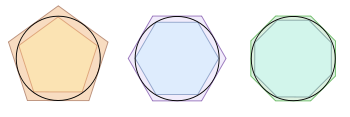- I hope that you had a relaxing or otherwise profitable fall break.
- 10.2 Homework returned:
- 2 -- factor, and simplify!
- factor out the common
- combine powers of t
- factor out the common
- 8 --
- two ways to get the tangent line
- Tangent lines should be linear functions!
- 43 -- simplify the integrand. Some of you gave up too early. Back to algebra...
- 2 -- factor, and simplify!
- Sorry, I've not graded your 10.3 homework yet.
-
Here's our first example of a sequence:
- Let's start by taking a peek at p. 716, for review of the
fundamental notion of convergence. It's a challenge....
- Definition: A sequence is a function f(n) whose
domain is a subset of the integers. The values
are called the terms of the sequence and n is called the index. For most of our sequences, the domain will be the natural numbers: {1, 2, 3, ....}.
- In the example sequence above, what do you suppose is the limit of
the sequence as
?

- There are lots of other sequences that we might encounter
naturally: for example, there's one in probability and statistics that
is closely related to the one we just looked at: the Poisson
distribution, which has as its probabilities the sequence
(what do you notice about the sum of the terms?).
- Other sequences might be defined in terms of a function. For
example,
where
- #3, p. 724
- #6
Other sequences are defined by "recurrence" (e.g. the Fibonacci numbers)
Example:
- #12, p. 724

Here's an especially interesting historical limit:

- One piece of good news: the obvious rules for limits are working:

Examples:
- #26, p. 724
- #27
- #29
- Some vocabulary: bounded sequences....

And some theorems related to this notion:

(especially useful for alternating sequences)

(note that the converse is false)

Let's use Theorem 6 to show that the sequence we initially considered is convergent:

- Geometric sequence: a sequence of the form
where r is called the common ratio.
- Examples:
- #23, p. 724
- #67
- #80

What would we get if we could add up all these (infinite!) terms? (148.4131591025766....)